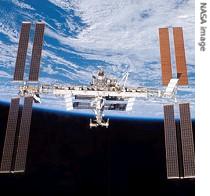2007年VOA标准英语-Female Astronauts Discuss Upcoming US Missions
时间:2019-01-31 作者:英语课 分类:2007年VOA标准英语(八月)
Houston
02 August 2007
In October, NASA, the U.S. Space Agency, plans major additions to the International Space Station (ISS) in two separate missions, both of which will be under the command of female astronauts. The two women who will lead the missions spoke 1 with reporters from their training site at the Johnson Space Center in Houston Thursday. VOA's Greg Flakus has this report from Houston.

Peggy Whitson
Astronauts Peggy Whitson and Pam Melroy have been in space before and, in fact, both were involved in a previous mission to enhance the capabilities 2 of the international space station in 2002. In October, Whitson will lift off aboard a Russian Soyuz spacecraft that will take her to the space station, where she will be in command of the Expedition 16 crew until she returns to earth in April of next year.
Melroy will command the STS-120 NASA Space Shuttle mission, which is targeted for launch on October 20. It will be a 13-day mission with the prime objective of delivering and installing a pressurized nodule known as Node 2 on the international space station. It will serve as a passageway to science labs on the complex.
Sitting side by side at the Johnson Space Center, both Whitson and Melroy expressed delight at being able to work together again in space.
WHITSON: "Pam and I had an opportunity to fly together the last time I was in space, STS-112 arrived and she was the pilot on board. So it will be fun to kind of rejoin again on orbit, this time with slightly different roles.

Pam Melroy
MELROY: "I feel the same way Peggy does. I think it really helps us a lot that we are familiar with what our shared expectations are and so forth 3 and so it has just been really easy preparing for this mission together."
Pam Melroy says that while there is joy in going into space and carrying out missions with other trusted professionals, there is also a sense of firm resolution to carry out a demanding set of tasks.
"It is a complicated mission," she said. "It is not just the delivery of Harmony, which is Node TWO, the centerpiece that will join all the international laboratories, we are also going to be relocating the P-SIX solar array, which is currently on top of the Z-ONE Truss and we will be moving it a long distance out, all the way to the end of the port truss. So, essentially 4, we have two large pieces of the station that we are doing assembly operations with and that is kind of unusual."
Once the Space Shuttle departs, the rest of the assembly job will fall on Whitson and her crew at the space station.
"Pam's crew is going to temporarily store Harmony on the side of Node-ONE and we actually have to move it from the side up forward," she added.

International Space Station (file photo)
She says performing all the necessary tasks will involve robotic maneuvers 5 as well as space walks or EVAs, extra-vehicular activity, in NASA parlance 6.
Properly installing the new module 7 and other procedures to be carried out by the space station crew will allow future shuttle missions to successfully dock with the orbiting complex.
Asked how they plan to commemorate 8 this first-time event of two female astronauts commanding missions in space at the same time, Pam Melroy said she looks forward to greeting her friend through the port after the shuttle docks.
"I confess I am really looking forward to that first handshake across the hatch. That will be all the commemoration I need is a picture of that," she said.
Pam Melroy retired 9 from the US Air Force with the rank of colonel in February. She piloted two previous shuttle missions and has logged over 562 hours in space. Peggy Whitson, who has a doctorate 10 degree in biochemistry, went to the international space station on one previous mission, aboard STS-111 in June, 2002. She spent six months in orbit and carried out 21 investigations 11 in human life sciences and microgravity science while there.
- They sourced the spoke nuts from our company.他们的轮辐螺帽是从我们公司获得的。
- The spokes of a wheel are the bars that connect the outer ring to the centre.辐条是轮子上连接外圈与中心的条棒。
- He was somewhat pompous and had a high opinion of his own capabilities. 他有点自大,自视甚高。 来自辞典例句
- Some programmers use tabs to break complex product capabilities into smaller chunks. 一些程序员认为,标签可以将复杂的功能分为每个窗格一组简单的功能。 来自About Face 3交互设计精髓
- The wind moved the trees gently back and forth.风吹得树轻轻地来回摇晃。
- He gave forth a series of works in rapid succession.他很快连续发表了一系列的作品。
- Really great men are essentially modest.真正的伟人大都很谦虚。
- She is an essentially selfish person.她本质上是个自私自利的人。
- He suspected at once that she had been spying upon his maneuvers. 他立刻猜想到,她已经侦察到他的行动。 来自辞典例句
- Maneuvers in Guizhou occupied the Reds for four months. 贵州境内的作战占了红军四个月的时间。 来自辞典例句
- The term "meta directory" came into industry parlance two years ago.两年前,商业界开始用“元目录”这个术语。
- The phrase is common diplomatic parlance for spying.这种说法是指代间谍行为的常用外交辞令。
- The centre module displays traffic guidance information.中央模块显示交通引导信息。
- Two large tanks in the service module held liquid oxygen.服务舱的两个大气瓶中装有液态氧。
- This building was built to commemorate the Fire of London.这栋大楼是为纪念“伦敦大火”而兴建的。
- We commemorate the founding of our nation with a public holiday.我们放假一日以庆祝国庆。
- The old man retired to the country for rest.这位老人下乡休息去了。
- Many retired people take up gardening as a hobby.许多退休的人都以从事园艺为嗜好。
- He hasn't enough credits to get his doctorate.他的学分不够取得博士学位。
- Where did she do her doctorate?她在哪里攻读博士?
- His investigations were intensive and thorough but revealed nothing. 他进行了深入彻底的调查,但没有发现什么。
- He often sent them out to make investigations. 他常常派他们出去作调查。